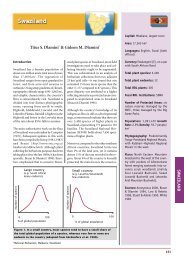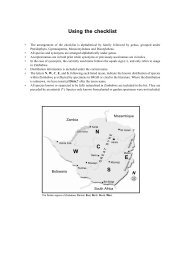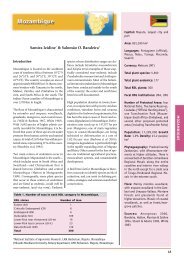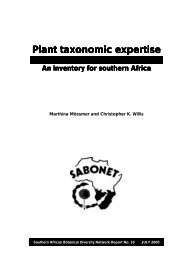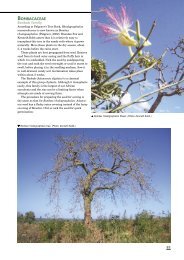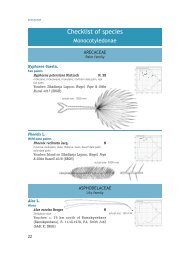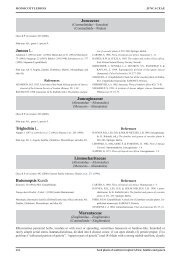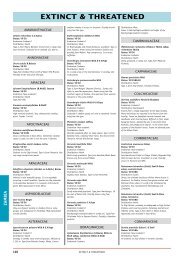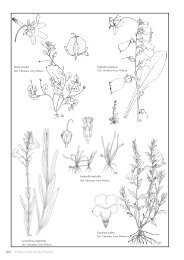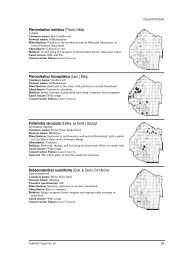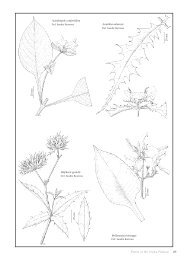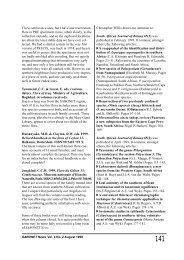Introduction - SABONET
Introduction - SABONET
Introduction - SABONET
Create successful ePaper yourself
Turn your PDF publications into a flip-book with our unique Google optimized e-Paper software.
ii<br />
Quick Guide<br />
This book is divided into two sections: the first part provides descriptions of some common<br />
trees and shrubs of Botswana, and the second is the complete checklist.<br />
The scientific names of the families, genera, and species are arranged alphabetically.<br />
Vernacular names are also arranged alphabetically, starting with Setswana and followed by<br />
English. Setswana names are separated by a semi-colon from English names.<br />
A glossary at the end of the book defines botanical terms used in the text.<br />
Species that are listed in the Red Data List for Botswana are indicated by an ® preceding the<br />
name.<br />
The letters N, SW, and SE indicate the distribution of the species within Botswana according to<br />
the Flora zambesiaca geographical regions.<br />
Flora zambesiaca regions used in the checklist.<br />
Administrative District FZ geographical region<br />
Central District SE & N<br />
Chobe District N<br />
Ghanzi District SW<br />
Kgalagadi District SW<br />
Kgatleng District SE<br />
Kweneng District SW & SE<br />
Ngamiland District N<br />
North East District N<br />
South East District SE<br />
Southern District SW & SE<br />
NAMIBIA<br />
NGAMILAND DISTRICT<br />
GHANZI DISTRICT<br />
KGALAGADI DISTRICT<br />
CHOBE<br />
DISTRICT<br />
KWENENG DISTRICT<br />
CENTRAL DISTRICT<br />
DISTRICT<br />
SOUTHERN<br />
SOUTH EAST<br />
DISTRICT<br />
DISTRICT<br />
0 Kilometres 400<br />
ZIMBABWE<br />
NORTH EAST<br />
DISTRICT<br />
KGATLENG<br />
N<br />
SOUTH AFRICA
Trees of Botswana:<br />
names and distribution<br />
Moffat P. Setshogo & Fanie Venter<br />
iii
Recommended citation format<br />
SETSHOGO, M.P. & VENTER, F. 2003. Trees of Botswana: names and distribution.<br />
Southern African Botanical Diversity Network Report No. 18. Pretoria.<br />
Produced by<br />
University of Botswana Herbarium<br />
Private Bag UB00704<br />
Gaborone<br />
Tel: (267) 355 2602<br />
Fax: (267) 318 5097<br />
E-mail: setshogo@mopipi.ub.bw<br />
Published by<br />
Southern African Botanical Diversity Network (<strong>SABONET</strong>),<br />
c/o National Botanical Institute, Private Bag X101, 0001 Pretoria<br />
and University of Botswana Herbarium, Private Bag UB00704, Gaborone.<br />
Printed in 2003 in the Republic of South Africa by Capture Press, Pretoria, (27) 12 349-1802.<br />
ISBN 1-919795-69-3<br />
© 2003 <strong>SABONET</strong>. All rights reserved. No part of this publication may be reproduced or transmitted in any<br />
form or by any means without the permission of the copyright holder. The University of Botswana Herbarium<br />
(address above) would appreciate receiving a copy of any publication that uses this report as a<br />
source.<br />
Cover pictures: front cover: Hyphaene petersiana; Kigelia africana; Adansonia digitata; Aloe marlothii<br />
var. marlothii; Acacia hebeclada subsp. chobiensis.<br />
back cover: Bauhinia petersiana subsp. macrantha, flower; Sterculia rogersii, fruit; Terminalia prunioides,<br />
fruit; Bauhinia petersiana subsp. macrantha; Sterculia rogersii, fruit.<br />
Editor-in-chief: Marthina Mössmer. Scientific editor: Otto Leistner. Sub-editor: Lidia Gibson.<br />
Cover design: Antoinette Burkhardt, Pretoria, South Africa (27) 82 909-0109.<br />
Text design and layout: Antoinette Burkhardt.<br />
<strong>SABONET</strong> web site: http://www.sabonet.org<br />
This report is a joint product of the University of Botswana Herbarium and the Southern African Botanical<br />
Diversity Network (<strong>SABONET</strong>) and was made possible through support provided by the Global Environment<br />
Facility (GEF)/United Nations Development Programme (UNDP) and the United States Agency for International<br />
Development (USAID)/World Conservation Union-Regional Office for southern Africa (IUCN ROSA)<br />
(Plot no. 14818 Lebatlane Road, Gaborone West, Extension 6 Gaborone, Botswana), under the terms of<br />
Grant No. 690-0283-A-00-5950. The opinions expressed herein are those of the authors and do not necessarily<br />
reflect the views of USAID, the GEF/UNDP, the <strong>SABONET</strong> Steering Committee or <strong>SABONET</strong> National<br />
Working Groups.<br />
iv
Trees of Botswana:<br />
names and distribution<br />
by<br />
Moffat P. Setshogo & Fanie Venter<br />
2003<br />
Southern African Botanical Diversity Network Report No. 18<br />
v
vi<br />
University of Botswana Herbarium<br />
Rev. Dr P.J. Mott established the University<br />
of Botswana Herbarium in 1973 as part of the<br />
University of Botswana, Lesotho, and<br />
Swaziland (UBLS). In 1980, the herbarium was<br />
registered and listed in the Index Herbariorum.<br />
Two years later it became the Herbarium of<br />
the University of Botswana (UCBG).<br />
UCBG is a teaching and research facility administered<br />
by the Department of Biological<br />
Sciences. It serves students and staff members<br />
who require assistance—mostly in plant<br />
taxonomy. In addition, the herbarium offers assistance<br />
to government institutions, non-governmental<br />
organisations, other researchers, and<br />
members of the public. The herbarium charges a<br />
fee for commercial or private consultancy.<br />
The Herbarium Plant Collection<br />
The herbarium contains about 10,000 specimens<br />
collected from different parts of Botswana,<br />
and a few from neighbouring countries.<br />
The collection is made up of carefully<br />
collected, preserved, dried, mounted, and labelled<br />
plant specimens. The collection is arranged<br />
by family according to the Cronquist<br />
Classification System. Most of the collections in<br />
the herbarium are by J.M. Woollard and P.J. Mott.<br />
Activities and Services<br />
Some of the main activities and services provided<br />
by UCBG are:<br />
• Collecting and preserving plant specimens<br />
from different regions of Botswana<br />
•Encoding the herbarium specimens using the<br />
PRECIS database<br />
• Serving as a standard reference for identifying<br />
newly collected plant specimens<br />
• Serving as a reference collection for Plant<br />
Taxonomy and other botanical courses provided<br />
by the university, and trains students<br />
in herbarium practices<br />
•Providing information on plant diversity,<br />
distribution, and promoting awareness in<br />
plant conservation and utilization<br />
•Providing information on plant vernacular<br />
names<br />
Funding<br />
UCBG functions, activities, and equipment<br />
are budgeted for under the Department of Biological<br />
Sciences. It has, however, benefited<br />
considerably from the <strong>SABONET</strong> project since<br />
1997.<br />
<strong>SABONET</strong> funding has made it possible to<br />
purchase a computer and PRECIS Database<br />
software, which is being used to encode and<br />
keep a record of the specimens in the herbarium.<br />
Projects<br />
<strong>SABONET</strong> is assisting UCBG and GAB in the<br />
compilation of the Poaceae Checklist (GAB),<br />
the National Tree List (UCBG), and the National<br />
Checklist (UCBG).<br />
Additional projects include:<br />
•A compilation of vernacular plant names<br />
(in collaboration with the National Herbarium<br />
(GAB), Sebele (MAH), and Peter<br />
Smith Herbarium (PSUB))<br />
•The Flora of Botswana project<br />
• An inventory of useful indigenous plants of<br />
Botswana<br />
Literature<br />
The library collection is mainly from donations<br />
by <strong>SABONET</strong>, from other herbaria, and<br />
research reports. Some books are on permanent<br />
loan from the University of Botswana<br />
library. UCBG is well equipped with a small<br />
literature collection of about 1,000 books.<br />
Contact address<br />
The Curator<br />
University of Botswana Herbarium<br />
Private Bag UB00704, Gaborone, Botswana<br />
Tel: (267) 355 2587<br />
Fax: (267) 318 5097
Contents<br />
Acknowledgements .............................................................................................. viii<br />
<strong>Introduction</strong> .......................................................................................................... 1<br />
Descriptions of some common trees of Botswana ......................................................... 4<br />
Checklist of species ............................................................................................... 22<br />
Colour plates ....................................................................................................... 71<br />
Species possibly occurring in Botswana ................................................................... 130<br />
Red Data Listed and protected tree species .............................................................. 132<br />
Glossary ............................................................................................................. 133<br />
References and further reading .............................................................................. 137<br />
Index ................................................................................................................ 138<br />
vii
viii<br />
Acknowledgements<br />
A number of people have contributed to make this list a reality. Special thanks are extended<br />
to Hester Steyn (National Botanical Institute) who produced the distribution maps. This was an<br />
onerous task, which she carried out diligently. Christopher Willis is remembered for the encouragement<br />
and support at the beginning of the project. Lidia Gibson and Marthina Mössmer<br />
edited the text, and Antoinette Burkhardt was responsible for the attractive layout of the<br />
book. We also thank Dr Otto Leistner for scientific editing and Marietjie Steyn for making lastminute<br />
drawings. We thank the <strong>SABONET</strong> Project and its Steering Committee for including this<br />
publication in the <strong>SABONET</strong> Report Series and for providing us with financial support.
There are approximately 3 200 species of<br />
flowering plants recorded for Botswana: no<br />
comprehensive checklist exists for these. Similarly,<br />
no checklist has been compiled for trees<br />
at a national level. Information on tree species<br />
of Botswana is scattered in various regional<br />
publications (Coates Palgrave 2002, Van<br />
Wyk & Van Wyk 1997, Van Wyk et al. 2000,<br />
Van Rooyen 2001). Books by Ellery & Ellery<br />
(1997) and Roodt (1998) consider a few common<br />
trees and those of ethnobotanical importance<br />
in the Okavango Delta. Timberlake<br />
(1980) gives the only comprehensive account<br />
of the genus Acacia in Botswana.<br />
This book, therefore, represents the first<br />
attempt at producing a national checklist of<br />
tree species recorded for Botswana—it lists<br />
approximately 440 species of indigenous trees.<br />
It does not claim to be exhaustive, and will be<br />
expanded as more data becomes available.<br />
Definitions<br />
The definitions of a tree and a shrub used<br />
in this book follow Venter & Venter (1996): a<br />
tree is any perennial woody plant growing to<br />
a height of at least 2 m, while a shrub is less<br />
than 2 m tall and mostly multi-stemmed.<br />
Data collection<br />
Data on the distribution of the species was<br />
gathered during numerous field trips covering<br />
literally the whole country. Information<br />
was also gathered from herbarium specimens<br />
<strong>Introduction</strong><br />
at the following herbaria: FHO, GAB, K, NH,<br />
PRE, PSUB, SRGH, UCBG, UNIN, and WIND (herbarium<br />
codes according to Holmgren et al.<br />
1990; Smith & Willis 1999). Voucher specimens<br />
for the different species are indicated<br />
together with the herbaria housing them.<br />
Arrangement of the list<br />
The book is divided into two sections: the<br />
first part provides descriptions of some common<br />
trees and shrubs of Botswana, and the<br />
second is the complete checklist.<br />
Circumscription of families and genera follows<br />
Leistner (2000). To ease reference, the<br />
scientific names of the families, genera, and<br />
species are arranged alphabetically. Similarly,<br />
the vernacular names are also arranged alphabetically,<br />
starting with the Setswana name(s)<br />
and followed by the English ones. Setswana<br />
names are separated by a semi-colon (;) from<br />
the English names. Species that are listed in<br />
the Red Data List for Botswana (Setshogo &<br />
Hargreaves 2002) are indicated by an ® preceding<br />
the name.<br />
A distribution map and line drawing of the<br />
leaves accompany every taxon in the list. The<br />
maps were created in MAPPIT, based on PRECIS<br />
data. Fanie Venter and Marietjie Steyn made the<br />
leaf drawings.<br />
A glossary at the end of the book defines<br />
botanical terms used in the text.<br />
1
Sources of vernacular names<br />
Vernacular names in the list were obtained<br />
in the following ways:<br />
• Recorded during the field trips from local<br />
informants.<br />
• From lists published from a number of<br />
other sources, for example, Campbell &<br />
Hitchcock (1985) and Woollard<br />
(1981, 1984). Literature was used extensively<br />
for the English names.<br />
• From herbarium specimens, which often<br />
had Setswana names recorded<br />
against them.<br />
For Setswana names, no attempt was made<br />
to indicate either the tribe (or dialect) or part<br />
of the country where the name was in com-<br />
Table 1. Flora zambesiaca regions cited in the checklist.<br />
2<br />
Administrative District FZ geographical region<br />
Central District SE & N<br />
Chobe District N<br />
Ghanzi District SW<br />
Kgalagadi District SW<br />
Kgatleng District SE<br />
Kweneng District SW & SE<br />
Ngamiland District N<br />
North East District N<br />
South East District SE<br />
Southern District SW & SE<br />
mon use. More research is needed before this<br />
can be done. An exception is with the San/<br />
Sesarwa names of Acacia species, which are<br />
listed according to Timberlake (1980).<br />
Distribution of the species<br />
The letters N, SW, and SE indicate the distribution<br />
of the species within Botswana according<br />
to the Flora zambesiaca (FZ) geographical<br />
regions (Pope & Pope 1998). These<br />
are explained in Table 1.<br />
The maps show the division of Botswana<br />
into administrative districts (Figure 1) and FZ<br />
geographical regions (Figure 2). The distribution<br />
maps for individual species are based on<br />
herbarium collections.
NAMIBIA<br />
KGALAGADI DISTRICT<br />
NGAMILAND DISTRICT<br />
GHANZI DISTRICT<br />
CHOBE<br />
DISTRICT<br />
KWENENG DISTRICT<br />
SOUTHERN<br />
DISTRICT<br />
CENTRAL DISTRICT<br />
0 Kilometres 400<br />
Figure 1: Administrative districts of Botswana.<br />
SW<br />
N<br />
SE<br />
SOUTH EAST<br />
DISTRICT<br />
ZIMBABWE<br />
KGATLENG<br />
DISTRICT<br />
N<br />
NORTH EAST<br />
DISTRICT<br />
SOUTH AFRICA<br />
Figure 2: Flora zambesiaca geographical regions. (Source: Pope & Pope 1998)<br />
3
Arecaceae<br />
4<br />
Descriptions of some common trees of Botswana<br />
This section contains descriptions of a few common and useful species in the list. They are<br />
arranged alphabetically by family, and alphabetically by genus and species within families.<br />
A glossary at the end of the book defines botanical terms used in the text.<br />
Monocotyledonae<br />
ARECACEAE<br />
Palm Family<br />
Hyphaene petersiana Klotzsch ex Mart.<br />
mokolane, mokolwane; northern ilala palm, real fan palm<br />
A medium-sized palm tree with a single bare and straight<br />
stem. The stem often has scars from where the old leaves have<br />
fallen off. The leaves are fan-shaped, with long stalks having<br />
recurved thorns. The male and female flowers are on separate<br />
individuals. The fruit is characteristically brown to reddish brown.<br />
The plant is defoliated to expose the stem and the sap is<br />
collected from these stems. It is then distilled into an alcoholic<br />
beverage called muchame. The use of the palm this way, however,<br />
is worrisome, since it destroys the whole plant. This is a<br />
very difficult species to propagate and is a slow grower.<br />
The nuts are eaten raw. The leaves<br />
are used to make baskets: the species<br />
is one of the major species supporting<br />
the basket industry in the<br />
Okavango Delta.<br />
H. petersiana occurs in sizeable numbers in the area stretching<br />
from Nata village, westward to the Okavango Delta, where it<br />
occurs mostly on seasonally flooded areas. It is thought to be<br />
an indicator of saline soils.<br />
Dicotyledonae<br />
ANACARDIACEAE<br />
Mango family<br />
Rhus lancea L.f.<br />
moshabela, mosilabele, motshotiso, motshotlho, nsasane, nseseni; bastard<br />
willow, karee, karoo tree, willow rhus<br />
actual size: 1300 mm
This is a small to medium-sized evergreen tree normally occurring<br />
in varying habitats. It has a characteristic rough dark<br />
brown bark. Leaves of the species have differently coloured surfaces;<br />
they are dark green above and paler green below. The<br />
leaves give out a characteristic aromatic smell when crushed.<br />
The fruit is a small, edible, flattened, dull yellow to brown drupe.<br />
The fruit can be pounded with water and allowed to ferment<br />
to make a good beer (Van Wyk & Van Wyk 1997). The wood is<br />
hard, tough, and durable. It is valuable as fencing posts and is<br />
used to make handles for some implements. The bark<br />
of R. lancea is also used for tanning. The tree can be<br />
cultivated as a garden ornamental.<br />
This tree can be confused with Rhus leptodictya, actual size: 102 mm<br />
from which it is separated by the nature of the leaves.<br />
The margins of the leaflets are entire in R. lancea and toothed<br />
in R. leptodictya (see description of R. leptodictya below).<br />
Rhus leptodictya Diels<br />
lehata-la-basimane, mogogobadimo, motshotlho, motshotlwane, nsasane;<br />
mountain karee, rock rhus<br />
This is a small to medium-sized evergreen tree with somewhat<br />
drooping branches. The trifoliate leaves have leaflets<br />
with toothed margins, join the leaf petiole at the<br />
same point and are almost at right angles to each<br />
other. The fruits are small, edible, flattened,<br />
orange-red drupes.<br />
Intoxicating liquor can be made<br />
from the fruit (Roodt 1998).<br />
actual size: 104 mm<br />
Sclerocarya birrea (A.Rich.) Hochst. subsp. caffra<br />
(Sond.) Kokwaro<br />
morula, morwa, ntala, nthula; cider tree, marula tree<br />
A medium to large deciduous tree with an erect trunk and a<br />
spreading, rounded crown; dioecious. Leaves are crowded near<br />
the ends of branches. Fruit is yellow when ripe, with a very<br />
juicy mesocarp.<br />
The most valuable asset of this tree is its fruit; therefore the<br />
tree is often conserved, even in cultivated lands.<br />
Marula fruits are rich in vitamin C and can be eaten<br />
ripe, but are popularly used to brew beer. A good<br />
jelly can be made from the pulp. The<br />
wood of S. birrea does not crack easily,<br />
hence it is used to make pestles<br />
for stamping grain. It is also suitable for drums, bowls,<br />
plates, and spoons. Seed kernels are rich in oil and<br />
Anacardiaceae<br />
actual size: 294 mm<br />
5
Bombacaceae<br />
protein. The bark is traditionally used for treating malaria.<br />
It is believed that a pregnant woman can influence the sex of<br />
the unborn child by drinking an infusion of the bark from either<br />
a male or a female tree.<br />
It occurs throughout the eastern, southeastern, and northern<br />
parts of the country, often growing at very low population<br />
densities per unit area.<br />
6<br />
BOMBACACEAE<br />
Baobab family<br />
Adansonia digitata L.<br />
dovuyu, ibozu, mbuyu, moana, mobuyu, mowana; Africa’s upside-down<br />
tree, baobab<br />
This tree is sometimes referred to as Africa’s upside-down<br />
tree (when leafless, the branches have the appearance of roots).<br />
It has a hugely swollen trunk. The fruit is large (up to 12 cm<br />
long), with a hard woody shell, and is covered by yellowish<br />
grey, velvety hairs on the outside. The seeds inside the fruit are<br />
embedded in a whitish powdery pulp.<br />
The leaves contain tannin in addition to<br />
mucilage, which is effective for the treatment<br />
of diarrhoea (Roodt 1998). The bark is used<br />
for making mats. The toxin in<br />
the latex of this plant includes<br />
a cardiac glucoside, strophanthin,<br />
which slows the heartbeat (Roodt 1998).<br />
Certain superstitious beliefs are associated<br />
with this species. Evil spirits will visit any<br />
person who plucks the flowers of the plant.<br />
It is also said that drinking water in which<br />
parts of the plant have been soaked provides<br />
protection against crocodiles.<br />
CAPPARACEAE<br />
Caper family<br />
Boscia albitrunca (Burch.) Gilg & Benedict var.<br />
albitrunca<br />
makgolela, mareko, monomane, motlopi, ntopi; caper bush, shepherds’ tree<br />
The trunk of this species is characteristically whitish<br />
(albitrunca). The leaves are clustered or fascicled on the branches.<br />
The fruits ripen to yellow, with a sweet, slimy pulp and a smooth<br />
actual size: 302 mm
skin. A delicious drink is prepared blending the fruits with milk.<br />
Coates Palgrave (2002) refers to this species as ‘a tree of life’<br />
because of the various uses it has to humans, livestock, and<br />
wild animals. The leaves provide nourishing fodder for game<br />
and livestock. A cold infusion of the leaf is used as a lotion for<br />
inflamed eyes of cattle. The wood is tough and durable; it is<br />
used to make household utensils such as spoons and bowls. A<br />
decoction of the root is said to be effective in the treatment of<br />
haemorrhoids (Roodt 1998). Birds, baboons, monkeys,<br />
elephants, as well as humans, eat the fruit.<br />
It is believed that if the wood of the species is burned,<br />
only male calves will be produced. It is also said that if the<br />
fruit withers before the sorghum crop harvest, the crop will fail.<br />
COMBRETACEAE<br />
Combretum family<br />
Combretum hereroense Schinz<br />
mokabi, mokata, mongare, monwana, mungave, nswazwi; mouse-eared<br />
combretum, russet bushwillow<br />
A small tree, 3–5 m in height. A characteristic feature of this<br />
species is its typical four-winged Combretum fruit (samara).<br />
However, this fruit is smaller than that of similar-sized<br />
combretums. It is rich dark reddish brown from an early age,<br />
becoming rich brown with golden-edged wings. The fruits remain<br />
on the tree for a long time.<br />
An infusion of the roots is used for stomach disorders (Roodt<br />
1998). Like all other combretums, the wood is very hard, tough<br />
and durable and it provides excellent firewood. It is termite and<br />
borer proof. Most browsers eat the leaves and small twigs of C.<br />
hereroense.<br />
Combretum imberbe Wawra<br />
kavimba, madikolo, mbgweti, monyondo, motswere, motswiri, movimba;<br />
bastard yellow wood, elephant trunk, ivory tree, leadwood<br />
This tree has a characteristic pale grey bark that cracks into<br />
rectangular flakes. Mature trees often have dead, bare branches<br />
and twigs. The grey-green foliage gives it a characteristic tinge<br />
throughout the year. The species flowers in October.<br />
According to Coates Palgrave (2002), a cough mixture can be<br />
prepared from the flowers.<br />
C. imberbe grows very slowly, forming exceptionally hard wood.<br />
Prior to the advent of iron implements, hoes were made of the<br />
timber and in the past it was used for railway sleepers, fencing<br />
posts, and mine props. The wood is very good fuel and is also<br />
actual size: 75 mm<br />
Combretaceae<br />
actual size: 43 mm<br />
7
Ebenaceae<br />
used to make grain mortars. The fruits make beautiful<br />
necklaces. Browsers eat the leaves and young twigs.<br />
The Herero worship this tree as an ancestor<br />
of all animals and people.<br />
Combretum molle R.Br. ex G.Don<br />
modubatshipi, mohudiri-wa-lentswe, molatswe; velvet bushwillow, velvetleaved<br />
combretum<br />
A small to medium-sized tree up to 10 m in height. The bark<br />
is grey, grey-brown to almost black, rough and fissured, and<br />
inclined to be flaky. Leaves are opposite and the apex tapers;<br />
the base is rounded to shallowly lobed and margins are entire.<br />
Flowers are greenish and heavily scented, attracting insects;<br />
they appear in September/October. The fruit is yellowish green<br />
flushed with red, drying to golden reddish brown.<br />
According to Roodt (1998), fresh or dry leaves of the species<br />
are used for dressing wounds. The leaf and the root are also<br />
believed to be an antidote for snakebite, while the root alone is<br />
used to treat both abortion and constipation. A feverish child<br />
is bathed in a decoction of the dried leaves to reduce its temperature,<br />
while an infusion of the inner bark is taken orally or<br />
as an enema to relieve various stomach complaints. The wood<br />
is hard and yellow; it is suitable for implement handles and<br />
fencing posts and is said to be reasonably termite-proof.<br />
8<br />
EBENACEAE<br />
Ebony family<br />
Diospyros lycioides Desf. sensu lato<br />
letlhaja, letlhajwa, molootsameno, motlhaja, nshangule; bluebush, hairy<br />
bluebush, Kalahari star-apple, red star-apple, Transvaal bluebush, velvet<br />
bluebush<br />
This plant occurs as a shrub in most parts of Botswana. The<br />
leaves are clustered towards the ends of branches. The plants<br />
are dioecious. The fruit is a berry, orange-red to dark red when<br />
ripe, usually with a persistent calyx.<br />
The bark is sometimes used for tanning. The root of this shrub<br />
is an excellent substitute for toothpaste.<br />
Euclea undulata Thunb. subsp. myrtina (Burch.)<br />
Hiern<br />
mokwelekwele, moshitondo, mosokola, motlhakola, motlhakolana,<br />
motlhakolane, motlhakolwana, motlhakolwane, motokola, nshangule-ntukunu;<br />
common guarri, fire-fighter’s blessing, small-leaved guarri, thicket euclea<br />
actual size: 84 mm<br />
actual size: 80 mm<br />
actual size: 36 mm<br />
actual size: 29 mm
This is a shrub with characteristic undulate leaves (with wavy<br />
margins). It has berry-like fruits of about 5 mm in diameter,<br />
which are initially brownish red, turning black at maturity.<br />
The roots are used medicinally for heart diseases, headaches,<br />
and toothaches (Van Wyk & Van Wyk 1997).<br />
EUPHORBIACEAE<br />
Euphorbia family<br />
Bridelia mollis Hutch.<br />
mokokokwena, mokokonane, mokokonyana, mokokwane, mokokwele,<br />
mokokwenana, mokokwenane, mokomanawe, mokopakopa, mokopokopo,<br />
mokororo, mongwanengebe, nkumbakumba; velvet bridelia, velvet<br />
sweetberry<br />
A small shrub common on rock outcrops and hills. It has<br />
characteristic velvety leaves (mollis). It produces a spherical<br />
edible fruit, green when immature, and turning black when<br />
mature.<br />
The wood is apparently not used for fuel because of a superstitious<br />
belief that its use might result in cows never<br />
bearing calves. The wood is, however, good for making<br />
implements, house timbers, and fences. The leaves are<br />
boiled and the solution rubbed on the body.<br />
Croton gratissimus Burch. var. gratissimus<br />
mhakwana, mmakwana, moologa, ngala-dombo, umumbango; lavender<br />
croton, lavender fever-berry<br />
This is a multi-stemmed tree of rocky places. Leaves are dark<br />
green above and silvery on the lower surface, dotted with many<br />
brown scales. There are two small glands where the stalk joins<br />
the leaf. Flowers are small and rather inconspicuous; they appear<br />
in October. The fruit is a small, three-lobed capsule.<br />
The leaves and bark are used medicinally. The tree is also<br />
very popular with boys who use its Y-shaped branches for making<br />
catapults. The slender stems of the species are used in<br />
the roofs of traditional huts.<br />
This species is generally characteristic of hills in southern<br />
Botswana.<br />
Schinziophyton rautanenii (Schinz) Radcl.-Sm.<br />
mokongwa, mongongo, mungongo; featherweight tree, manketti nut,<br />
manketti tree, mongongo nut<br />
actual size: 93 mm<br />
actual size: 88 mm<br />
Euphorbiaceae<br />
9
Fabaceae<br />
This species has a nutritious and well-known fruit. It is about<br />
35 mm long and 25 mm broad, eggshaped,<br />
fleshy with a hard seed or nut,<br />
which is extremely hard to crack. The<br />
kernels are yellowish-white, either<br />
eaten raw or roasted,<br />
and taste like cashew actual size: 143 mm<br />
nuts. The nut is<br />
pounded and cooked<br />
with a variety of vegetables<br />
(Story 1958).<br />
It is distributed in<br />
northern Botswana.<br />
Spirostachys africana Sond.<br />
morekhure, morukuru; African mahogany tree, African sandalwood, jumping<br />
bean tree, tamboti<br />
This tree is valued for its straight, upright, single bare trunk,<br />
which makes it amenable to many uses. The bark is characteristically<br />
dark to black and neatly cracked into regular rectangles.<br />
The plant produces a milky latex when its branches are injured.<br />
The species flowers in October.<br />
S. africana occurs in the eastern hardveld of Botswana. The<br />
wood is used to make splendid furniture. It provides hut poles<br />
and rafters and is also used for making sledges.<br />
10<br />
FABACEAE<br />
Pod-bearing family<br />
Acacia species<br />
actual size: 59 mm<br />
These are typical thorn bushes and thorn trees comprising a major part of the vegetation of<br />
Botswana. All acacias have bipinnate leaves, pairs of straight or hooked thorns, and flattened<br />
pods. Thorns and details of leaves are most important in separating species of this difficult<br />
genus. Flowers are fluffy, occurring in inflorescences of two types, a long spike and a round<br />
ball. All acacias are deciduous.<br />
Acacia erubescens Welw. ex Oliv.<br />
g//are (G//ana), moloto, murengambo, n!ã (!Kung), omungongomwi; blue<br />
thorn<br />
A small tree or bush. It has 4–6 pairs of pinnae of 10–15 pairs<br />
of leaflets. Leaflets are relatively small and it has vicious, hooked<br />
thorns. The bark of A. erubescens is pale, even cream, and sometimes<br />
flaking. The pods are pale-brown, thin, flat, and horizontally<br />
veined. This species can be confused with A. fleckii, but
the latter flowers later, has many more pinnae, has small leaflets,<br />
and has a shorter leaf stalk (see description of A. fleckii<br />
below). The species flowers in October.<br />
Livestock may browse leaves and pods. The bark is used for<br />
making rope used in thatching. The wood is<br />
used for firewood and fence posts.<br />
Acacia fleckii Schinz<br />
/kane, gare (G//ana), mfafu, mhahu, mohahu, mokoka, mokoko,<br />
mokokwane, mukona, n≠ahli (!Xõ), n≠eng (!Kung), omutaurambuku; blade<br />
thorn<br />
A tree or bush, with 6–15 pairs of pinnae of 10–30 pairs of<br />
densely crowded leaflets. Leaflets are grey-green, small and hairy.<br />
A. fleckii has a prominent gland near the base of the stalk and<br />
vicious, hooked thorns. Young twigs of A. fleckii are pale grey<br />
and slightly zigzag. Bark on the trunk is pale to cream, flaking.<br />
Pods are pale, brown, broad, thin, often slightly curled up and<br />
horizontally veined.<br />
Leaves are browsed by animals. The wood<br />
is used for firewood.<br />
Acacia karroo Hayne<br />
butema, gaba, mokha, mooka, mookana, mookane, orusu; gum Arabic tree,<br />
karoo thorn, mimosa thorn, sour thorn, sweet thorn, thorn tree, white thorn<br />
The characteristic features of this species include the following:<br />
a dark and rough bark; striking, long, paired, white thorns;<br />
yellow, sweet-smelling, ball-like flowers producing copious<br />
amounts of nectar. Sometimes called the ‘bee tree’ because bees<br />
in search of nectar visit it. It is one of the last acacias to flower<br />
in spring. The trees exposed to browsing by animals tend to be<br />
thornier, usually on lower branches where<br />
the animals can reach easily. The pods are<br />
sickle-shaped and dehisce by splitting<br />
lengthwise in the middle.<br />
This is a good fodder tree, browsed by<br />
cattle and goats. The bark can be used for<br />
tanning leather.<br />
Acacia mellifera (Vahl) Benth. subsp. detinens<br />
(Burch.) Brenan<br />
!gou (!Kung), //ha (!Xõ, Nharo), //kowa, //wa (G//ana), mongana, monka,<br />
more-o-mabele, mukona, nkoshwana, omusaona, ungandu; black thorn,<br />
hook thorn, wait-a-bit thorn<br />
This tree often bushes in large thickets. This species has 2–4<br />
pairs of pinnae and rarely possesses more than one pair of large<br />
leaflets. It also has many hooked thorns. Flowers of A. mellifera<br />
are sweet-smelling white balls, appearing just before or with<br />
the leaves. Pods are short, broad, papery, pale brown, and hori-<br />
actual size: 80 mm (pod)<br />
actual size: 80 mm (pod)<br />
actual size: 80 mm (pod)<br />
Fabaceae<br />
11
Fabaceae<br />
zontally veined. The fruits appear in October.<br />
This species can be confused with A. nigrescens (see description<br />
of A. nigrescens below) from which it is distinguished by<br />
the absence of knobs on stems and branches.<br />
A. mellifera is one of the most valuable fodder trees and is<br />
highly sought-after by game and livestock. It contains a high<br />
percentage of raw protein and is thus often ground up to feed<br />
game and livestock. It is used traditionally as medicine. For<br />
instance, roots can be used to relieve stomach complaints. It<br />
is often thought undesirable in the range<br />
when it encroaches on overgrazed areas. It<br />
is also an indicator of calcium-rich soils.<br />
Acacia nigrescens Oliv.<br />
goshwe, mokoba, more-o-mabele, mughandutji, mwanduchi, nkogo, yi<br />
(!Kung); knob-thorn<br />
This is usually a tree of up to 30 m in height. Its characteristic<br />
feature is the scattered, irregularly shaped knobs on the<br />
trunk and large branches. The leaflets are uncharacteristically<br />
large for an Acacia (up to 30 mm long by 20 mm wide), normally<br />
two pairs of pinnae per leaf.<br />
It can be confused with A. mellifera, from which it is distinguished<br />
by the leaflets and the knobs on the trunk and branches.<br />
Both A. mellifera and A. nigrescens are good barrier plants because<br />
of their vicious, hooked thorns, hence they are usually<br />
used in kraal and homestead fences.<br />
The tree is extremely fire resistant and is<br />
therefore an excellent firewood. The leaves are<br />
eaten eagerly by browsers.<br />
Acacia tortilis (Forssk.) Hayne subsp. heteracantha<br />
(Burch.) Brenan<br />
/gali (!Kung), mojwa, mokhu, morwane, moshaoka, moshu, mosu,<br />
mosunyana, mudjwa, nsu, orusu-orupunguya; curly-pod acacia, umbrella<br />
thorn<br />
This is a deciduous tree and usually not more than 10 m<br />
high. In northern Botswana (Moremi Game Reserve) some trees<br />
reach 20 m. The well known, conspicuous umbrella-shaped crown<br />
only develops fully in old specimens; young trees have roundish<br />
or flat-topped crowns. The stem is usually fairly short and the<br />
main branches are bare. Old bark is dark grey to black, longitudinally<br />
fissured and ridged. The sharp spines of A. tortilis are<br />
unique: some are short, blackish and hooked, while others are<br />
long, white and straight. The spines occur in pairs, mostly two<br />
of the same kind together, but sometimes mixed (thus a hooked<br />
and a straight spine together). The bipinnately compound leaves<br />
are probably the smallest among the thorn trees. The same ap-<br />
12<br />
actual size: 66 mm (pod)<br />
actual size: 66 mm (pod)
plies to the leaflets, which are minute (1.5 x 0.5 mm). The fruit<br />
consists of characteristic, pale brown pods, which are always<br />
spirally contorted and sometimes intertwined with each other.<br />
The wood is used as fuel. The pods are highly valued,<br />
showing contents of 18.83% protein, 2.44%<br />
fat, 46.25% carbohydrates, 5.1% minerals, and<br />
20.1% fibre (Roodt 1998). They are browsed by<br />
game and are also collected by farmers for feeding<br />
small stock. The tree is common on abandoned<br />
and old ploughed fields, and is an encroacher<br />
on heavily eroded lands.<br />
Burkea africana Hook.<br />
kudumela, monato, mosheshe, nkalati, ohehe; burkea, red syringa,<br />
Rhodesian ash, wild syringa<br />
This tree has a dark grey, rough and flaking bark. The leaves<br />
are crowded at the ends of branchlets. The fruit is a<br />
thin, flat, single-seeded, indehiscent pod,<br />
often persistent for months.<br />
The timber has been used for<br />
wagons and furniture. The<br />
pounded bark and fruit are<br />
used as a fish poison. The<br />
bark and fruit are also used<br />
for tanning (Roodt 1998).<br />
Colophospermum mopane (Kirk ex Benth.) Kirk ex<br />
J.Léonard<br />
mophane, mpani; balsam tree, black ironwood, butterfly tree, mopane<br />
The species has a characteristic butterfly leaf. The fruit is a<br />
kidney-shaped pod, covered in oil glands.<br />
The southernmost distribution of the species in Botswana is<br />
just north of Radisele village. It usually dominates wherever it<br />
occurs, forming a distinct vegetation type called ‘Mopane woodland’.<br />
It is regarded as an indicator of shallow, poorly drained,<br />
often alkaline, soils. It is slow-growing outside its distribution<br />
range.<br />
C. mopane is the most sought-after building material in Botswana,<br />
as it is almost completely termite-resistant and the<br />
straight growth form of the young specimens lends itself to<br />
utilisation for this purpose. It is also ideal for fencing poles<br />
and wagon shafts. C. mopane is also a host for the commonly<br />
harvested phane worm in Botswana.<br />
It is thought that mopane trees attract lightning.<br />
actual size: 27 mm (pod)<br />
actual size: 432 mm<br />
actual size: 160 mm<br />
Fabaceae<br />
13
Fabaceae<br />
Dichrostachys cinerea (L.) Wight & Arn. sensu lato<br />
moselesele, mpangale; hairy sickle bush, Kalahari Christmas tree, largeleaved<br />
sickle bush, sickle bush, velvet sickle bush<br />
This species is deciduous and grows as a spiny bush, often<br />
forming thickets. It can have 4–13 pairs of pinnae with 10–25<br />
pairs of small, crowded leaflets. Leaves grow from short spinetipped<br />
side twigs. The flowers are distinctive dropping tassels,<br />
with upper part mauve to pink, and lower part narrower and<br />
yellow. The thin, twisted pods grow in a tangled mass. Although<br />
the leaves of D. cinerea are like those of an Acacia, the absence<br />
of paired thorns or spines easily distinguishes this bush.<br />
There is a strong similarity of medicinal application throughout<br />
Africa, even in the most remote regions, for example, treatment<br />
for snake-bite, which is prepared by chewing the leaf well<br />
and then applying it to the lesion by binding it with strips from<br />
the inner bark (Roodt 1998). D. cinerea is said to be an excellent<br />
cure for toothache and it is also considered a remedy for<br />
abdominal pains, pneumonia, internal abscesses, dysentery,<br />
gonorrhoea, worms, and maladies of the urinary tract, suggesting<br />
that the tree may have some antibiotic properties (Roodt<br />
1998). By inhaling the smoke of the dried leaves and root, chest<br />
complaints and a blocked nose can be relieved. Dried seed pods<br />
soaked in hot water make a soothing eyewash (Roodt 1998). An<br />
extract of the leaves mixed with salt is even more effective for<br />
this purpose.<br />
The wood is used for making fence poles and is good fuel. The<br />
timber is termite-resistant and so durable that it was once<br />
used instead of iron posts, since it withstands even veld-fires.<br />
The inner bark is tough and pliable and makes strong rope<br />
and string. The whole plant has a high nutrition value and<br />
the leaves and pods are eaten by livestock and wildlife.<br />
Elephantorrhiza burkei Benth.<br />
mbola, mosetlha-o-monnye, mosidi, mosidigodimo, mositsane; sumach<br />
bean, sumach elephant root<br />
This species is deciduous and it is a sparsely foliaged bush or<br />
small tree, usually growing on rocky hills. Leaves are large, with<br />
5 or 6 pairs of pinnae of 10–25 pairs of leaflets,<br />
spaced out. Leaflets are largish, oblong to ovate,<br />
with a pointed apex. E. burkei has no thorns,<br />
and a large, broad, flat woody pod. When mature,<br />
most parts of the pod fall away<br />
or roll up leaving just the rims. The<br />
species flowers in October. The large<br />
size of the leaf and the absence of any thorns<br />
distinguish this species from acacias.<br />
14<br />
actual size: 216 mm<br />
actual size: 2 mm
It is often used in leather tanning, but is not as popular as E.<br />
elephantina.<br />
Peltophorum africanum Sond.<br />
mosetlha, mosiru, moyeri, moyethu, moyevu, nzeze, setimamollo; African<br />
wattle, weeping wattle<br />
In summer, the abundant, pea-like, yellow flowers amongst<br />
the large, feathery leaves are characteristic. The tree has striking,<br />
dull green, large, Acacia-like, soft, feathery leaves. It<br />
branches low down from a trunk that is often crooked, to form<br />
a spreading, irregular and untidy crown. The flowers appear<br />
in November. It produces dark brown to black pods<br />
that remain on the tree for most of the year.<br />
The wood produces a smooth finish and seems promising<br />
for furniture use. It has also been used for<br />
wooden buckets, grinding blocks and even<br />
wagons in the past. Steam from a hot decoction<br />
is used to relieve sore eyes and the bark is usually<br />
chewed to treat abdominal pains (Roodt 1998).<br />
actual size: 230 mm<br />
MALVACEAE<br />
Hibiscus family<br />
Azanza garckeana (F.Hoffm.) Exell & Hillc.<br />
moroja, morojwa, ntobgwe; azanza, chewing gum tree, snot apple<br />
An evergreen shrub to medium-sized tree. Branchlets<br />
have woolly hairs. Leaves are 3–5-lobed, with rough,<br />
stellate (star-shaped) hairs on the upper surface,<br />
and soft hairs on the lower surface. Flowers<br />
are solitary, yellow, with a maroon<br />
patch in the centre. The fruit is a<br />
yellowish green to brown, five-lobed<br />
woody capsule, and is edible.<br />
The species is northern in distribution and its<br />
occurrence in the south is probably due to introductions.<br />
MORACEAE<br />
Fig family<br />
Ficus abutilifolia (Miq.) Miq.<br />
mhawa, mohawa, mokoyo, momelantsweng, mpawa, ntulukuse; largeleaved<br />
rock fig<br />
actual size: 332 mm<br />
Malvaceae<br />
15
Olacaceae<br />
The species has the following characteristics:<br />
roots that grow over rocks<br />
(‘rock splitters’); a whitish grey<br />
trunk; large, roundly heart-shaped<br />
leaves with prominent veins. The<br />
species flowers<br />
in August/<br />
September,<br />
and the fruits appear in October.<br />
The figs are edible, even though<br />
nearly always infested with insects.<br />
This is a common tree on hills.<br />
16<br />
OLACACEAE<br />
Sourplum family<br />
Ximenia americana L. sensu lato<br />
chibitswa, moretologana, moretologa-wa-pudi, moretonoga, moretonoha,<br />
motsididi, nswanja-bakhwa, seretologa; blue sourplum, small sourplum<br />
This is a much-branched shrub or small tree with a bluegreen<br />
appearance. Leaves occur in axils of straight spines or are<br />
clustered on short side branches, folding inwards along the main<br />
vein. The plants are dioecious. The species flowers in November.<br />
Fruits are yellowish red and fleshy.<br />
The fruit is sour, but edible, and is often used to make beer.<br />
The leaf, which contains tannin and resins, is used as a remedy<br />
for cough, fever, and wounds. The oily kernel is used for softening<br />
leather, as a cosmetic, and for making torches (Roodt 1998).<br />
The species can be confused with X. caffra, which has dark<br />
green leaves.<br />
Ximenia caffra Sond. sensu lato<br />
moretologa, moretologa-wa-kgomo, moretonoga, morokolo, motsidi,<br />
mwombe, nswanja-ngombe; hairy large sourplum, large sourplum, monkey<br />
plum<br />
This is a sparsely-branched shrub or small tree. Leaves are<br />
clustered on short side branches, are dark green in colour and<br />
fold inwards along the main vein. The plants are dioecious. The<br />
fruits are bright red, smooth and fleshy when ripe, and are<br />
edible.<br />
The species can be confused with X. americana, which has<br />
waxy, blue-green leaves. Both species are fairly widespread in<br />
Botswana.<br />
actual size: 286 mm<br />
actual size: 48 mm<br />
actual size: 68 mm
RHAMNACEAE<br />
Dogwood family<br />
Ziziphus mucronata Willd. subsp. mucronata<br />
mabyana-a-mala-a-tupa, moketekete, mokgalo, monganga, nchecheni;<br />
buffalo thorn, shiny leaf, wait-a-bit<br />
This is a shrub to a medium-sized tree. Young branches bend<br />
at the nodes, giving them a zigzag appearance. The leaves are<br />
shiny green. Paired thorns are present at the base of the leaf<br />
stalk; one is curved while the other is straight. The species<br />
flowers in October/November. The fruit is round, berry-like, shiny<br />
reddish to yellowish brown.<br />
A decoction of the roots is commonly administered as a painkiller.<br />
An infusion of the bark and leaves is used for chest complaints<br />
(Roodt 1998). Pastes of the root and leaves can be applied<br />
to treat boils and swollen glands. The leaves are an important<br />
source of fodder for stock, and all browsers feed on the<br />
tree. Impala often feed on the dead leaves lying under trees.<br />
The elasticity of the wood makes it suitable for bows and, especially,<br />
hammer handles. Ox yokes are cut from larger trees, while<br />
saplings and coppice shoots make whip sticks. As with most<br />
fruits, a beer can be made if fruit is allowed to ferment. The tree<br />
is a good indicator of the presence of underground water.<br />
In Botswana, this tree is considered immune to lightning, so<br />
any person sheltering under it is thought to be safe. It is also<br />
believed that if it is felled after the first rains, a drought will<br />
certainly ensue.<br />
RUBIACEAE<br />
Coffee family<br />
Vangueria infausta Burch. subsp. infausta<br />
mmilo, monyonyana, mothwane, nzwigwa; wild medlar<br />
This is a shrub to small tree, occurring mostly on rocky places<br />
and hills throughout Botswana. Its stems have prominent triangular<br />
stipules between each pair of leaves. It has boat-like<br />
leaves bent backwards in a sickle shape. Small gall-like growths<br />
may be noticed on the leaf surfaces. These are caused by a<br />
species of fungus, which often attacks these trees. V. infausta<br />
flowers in late October. It has roundish fruit, which can be up<br />
to 40 mm in diameter, with a glossy brown skin when ripe.<br />
actual size: 63 mm<br />
Rhamnaceae<br />
17
Sapindaceae<br />
The fruit is edible and contains a high level of vitamin C.<br />
Roots are used medicinally to treat malaria.<br />
It is considered unlucky to use the wood of<br />
this species, hence the specific epithet,<br />
infausta, which means unlucky. The wood is<br />
never used, not even as fuel.<br />
18<br />
SAPINDACEAE<br />
Litchi family<br />
Pappea capensis Eckl. & Zeyh.<br />
molalakgaka, mopanyobojalwa, mopenoene, mopenwaeng, mothata,<br />
ntorido; indaba tree, jacket plum, wild cherry<br />
Over most of its range the Jacket Plum is a small tree (7 m)<br />
but it can reach a height of 12 m. It is semi-deciduous and has<br />
a short trunk and a fairly dense, spreading crown. The leaves<br />
are usually crowded at the ends of the branches. They are simple,<br />
variable in size, hard and rough and the margins may be<br />
entire or finely spine-toothed. The outstanding characteristic<br />
feature of the tree is its fruit—these are softly hairy, green,<br />
round berries, about 15 mm in diameter. During some seasons<br />
the berries occur in masses. When ripe, the pericarp splits in<br />
two to reveal the bright red, fleshy, shining false aril, which<br />
envelops the black seed. This fleshy part is delicious and is<br />
enjoyed by people and animals. It is also used to make jelly and<br />
to brew an alcoholic beverage and vinegar.<br />
The wood has a fine grain and is quite heavy, hard and pale<br />
brown with a reddish tinge. The quality is good enough for it<br />
to be used for various purposes, but large pieces are<br />
rare. The leaves provide valuable browsing for<br />
game and stock. The seed can provide fairly heavy<br />
oil that is edible as suggested by Roodt (1998); it is<br />
claimed that farmers oil their guns with this oil.<br />
SAPOTACEAE<br />
Milkwood family<br />
actual size: 119 mm<br />
actual size: 74 mm<br />
Englerophytum magalismontanum<br />
(Sond.) T.D.Penn.<br />
motlhatswa; red milkwood, stemfruit, Transvaal milkplum,<br />
wild plum actual size: 79 mm
The fruits are plum-like, ovoid, about 20 mm in diameter, red<br />
when ripe, sweet and deliciously flavoured. They have a high<br />
vitamin C content. They are used for making syrup, brandy, and<br />
wine. This is a species occurring mostly on hills in southeastern<br />
Botswana.<br />
Mimusops zeyheri Sond.<br />
mmopudu, mmupudu, mobu, mosamtuza, mupudu; common red<br />
milkwood, Transvaal red milkwood<br />
This is a small to medium-sized evergreen tree. The parts<br />
exude a milky latex when injured. All young parts have dense<br />
reddish brown hairs. The leaves are glossy dark green and leathery.<br />
The flowers are star-shaped, white and scented, and appear<br />
in October. The fruit is oval, fleshy, orange, with a persistent<br />
style attached to it.<br />
The fruit is edible, eaten by both humans and animals. A<br />
juice is prepared from the fruit and can be used fresh or fermented.<br />
The fruit is commonly sold in local markets in November<br />
and December.<br />
STRYCHNACEAE<br />
Wild Elder family<br />
Strychnos cocculoides Baker<br />
mogorogoro, mogorogorwana, mogorogorwane, mohoruhoru, moruda,<br />
nhume; corky-bark monkey orange<br />
The fruit is large, spherical, about 80 mm in diameter, and<br />
yellowish when ripe. The juicy pulp is refreshing and has a<br />
delectable flavour when eaten fresh or crushed to make a fermented<br />
juice. It has a patchy distribution in the southeast, to<br />
the eastern and northern parts of the country.<br />
actual size: 48 mm<br />
Strychnos spinosa Lam.<br />
maume, mogorogoro, mogororo, moyimbili; elephant orange, green monkey<br />
orange, monkey ball, spiny monkey orange<br />
The fruits are bigger than those of S. cocculoides (about 120<br />
mm in diameter), spherical, deep yellow to yellow-brown in<br />
colour and fleshy. The pulp is sweet and has a delicate flavour.<br />
actual size: 73 mm<br />
actual size: 55 mm<br />
Strychnaceae<br />
19
Tiliaceae<br />
20<br />
TILIACEAE<br />
Jute family<br />
Grewia bicolor Juss.<br />
kukuruthwe, mambalane, mogwana, monabo, motuu, ntewa; bastard<br />
brandybush, false brandybush<br />
This is mostly a multi-stemmed shrub. The bark is dark grey,<br />
deeply fissured, and peels away in old specimens. Leaves are a<br />
dark, dull green above and almost silvery-white below (hence<br />
bicolor). The fruit is a drupe, one- or two-lobed, reddish brown<br />
to purple black.<br />
Although slightly sour, the fruit is eaten by humans when<br />
ripe or is dried for later use. It is also one of the ingredients for<br />
making traditional khadi brew. Fibre obtained from the inner<br />
bark is used for making ropes and baskets.<br />
Grewia flava DC.<br />
maphokwe, monabo, moreswe, moretlwa, moseme, ntewa, phomphokwe;<br />
brandybush, raisin tree, velvet raisin, wild currant, wild plum<br />
This is a multi-stemmed shrub. It has greyish green leaves.<br />
The species flowers in October. The fruit is usually two-lobed.<br />
The fruit has a high sugar content and although not very<br />
fleshy, is eaten fresh or dried. The fruit, like that of G. bicolor,<br />
is also one of the ingredients of a traditional brew, khadi. The<br />
bark provides a fibre from which baskets are woven and the<br />
frayed ends of the branchlets are used as toothbrushes. The<br />
foliage is browsed by livestock and game, particularly during<br />
the dry season when other food is scarce.<br />
Branches of G. flava are used to make baskets; very thin<br />
branches are used to make brooms. The inner bark is used to<br />
weave baskets. Pegs made from the wood of this species are put<br />
upright onto the roofs or driven into the ground to ward off<br />
lightning. According to Roodt (1998), it is also used in death<br />
rites by the Bakgalagadi tribe, where a piece of the inner bark is<br />
tied to the right arm of the dead man to ensure a type of spiritual<br />
bond with his children. The same is done to each of his<br />
children in sequence from the oldest to the youngest.<br />
Grewia flavescens Juss. sensu lato<br />
mokankele, motsotsojana, motsotsojane, mpuzu; donkey berry, river roughleaved<br />
raisin bush, rough-leaved raisin bush, sandpaper raisin<br />
This is a scrambling multi-stemmed shrub. Older stems are<br />
characteristically four-angled (rectangular). Leaves are covered<br />
with harsh hairs (hence giving the feel of sandpaper) and have<br />
actual size: 39 mm<br />
actual size: 54 mm
irregularly toothed margins. The fruit is 2–4-lobed and yellowish<br />
brown when ripe.<br />
The leaves are browsed by game and livestock. The wood is<br />
very tough and is commonly used to make walking sticks and<br />
bows.<br />
Grewia retinervis Burret<br />
mokankele, mokgomphatha, mopundu, mpuzu; arib, false sandpaper raisin,<br />
Kalahari sand raisin bush, rough-leaved raisin bush<br />
This is a shrub to small, bushy tree. The bark is brownish.<br />
Older branches tend to have grooves on two sides. The edible<br />
fruit is always single, spherical and is orange-red to reddish<br />
brown when ripe.<br />
The berries are a favourite with humans and can be eaten<br />
either raw or dried. An alcoholic beverage can be prepared from<br />
the fruit because of the high sugar content. The angular stems<br />
are used for spear shafts.<br />
Grewia species are fairly well distributed throughout Botswana.<br />
actual size: 63 mm<br />
actual size: 46 mm<br />
Tiliaceae<br />
21



